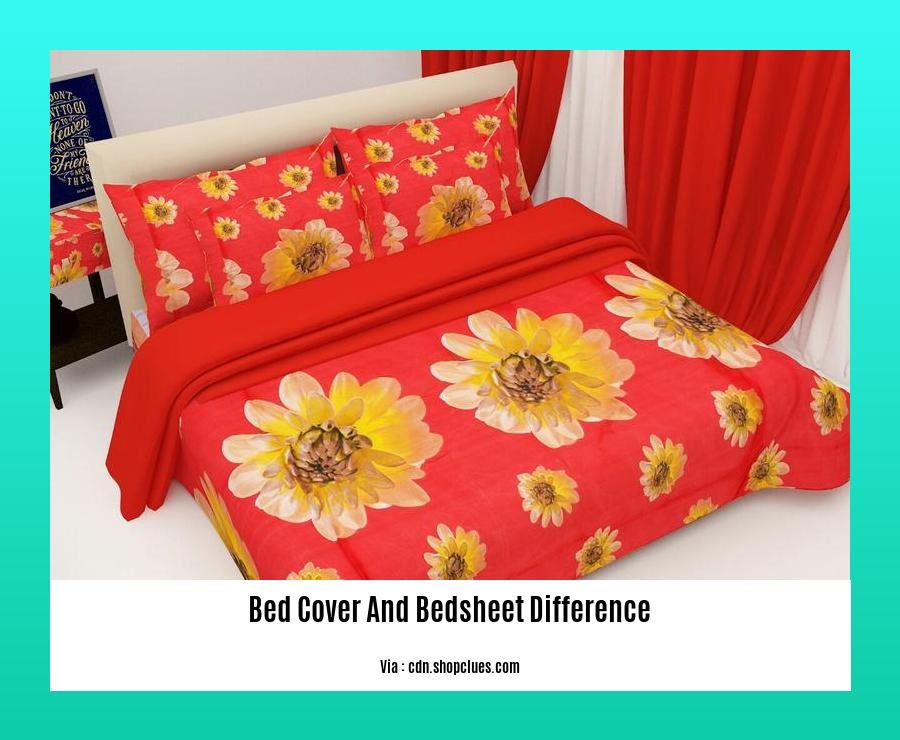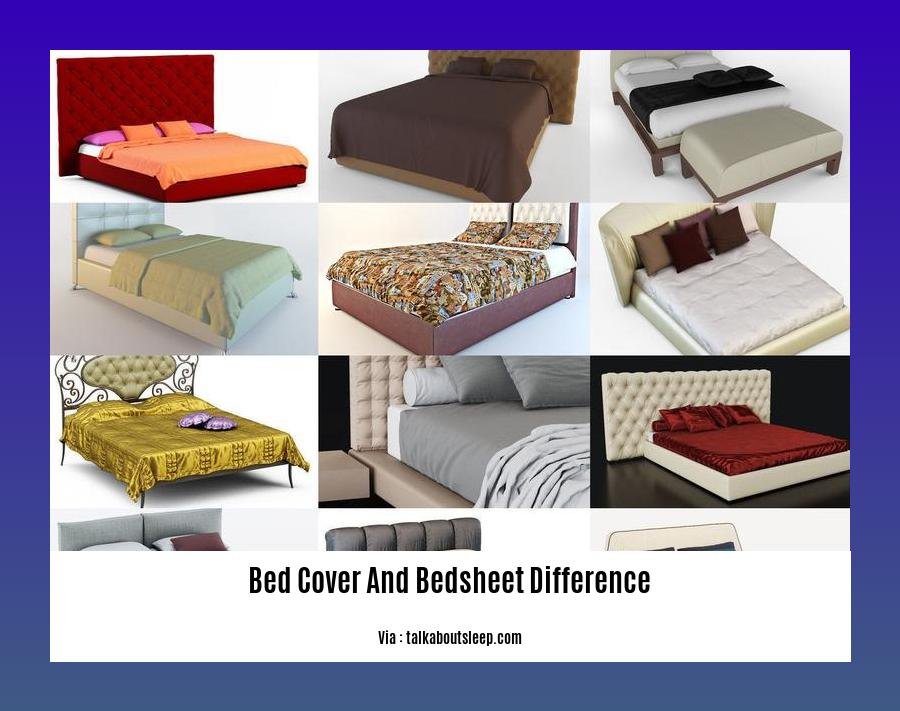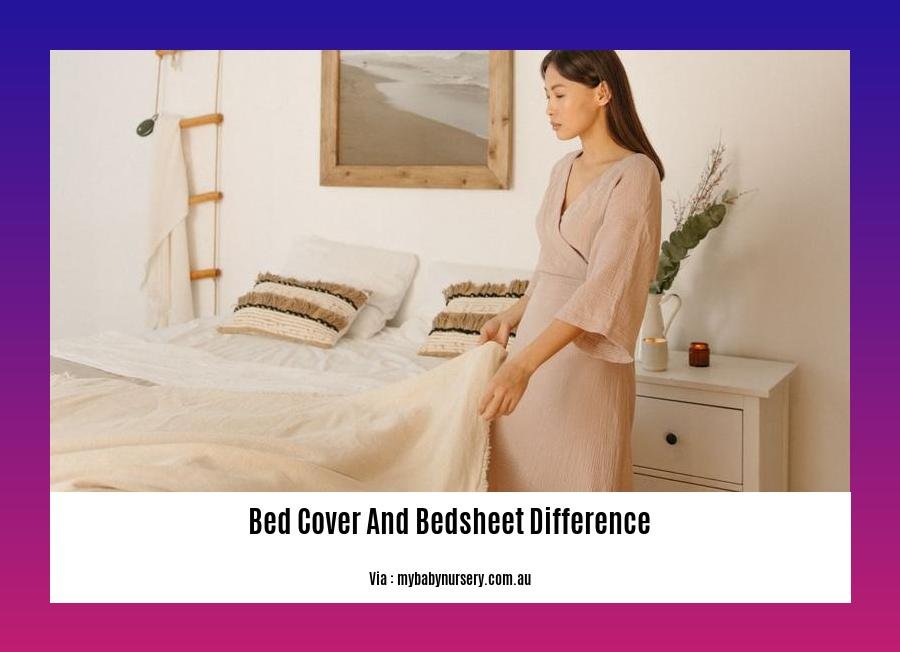Choosing the perfect bedding essentials is crucial in creating a comfortable and inviting bedroom space. One key aspect to consider is the difference between bed covers and bed sheets. Understanding this distinction is essential to making informed choices that align with your style, comfort, and functionality preferences. In this article, we will unravel the nuances of the bed cover and bedsheet difference, providing you with valuable insights into creating the ideal sleep sanctuary.
Key Takeaways:
- Bedsheets are used to cover the mattress itself, while bed covers go over the entire bed, including pillows and blankets.
- Bedsheets are thinner, lighter, and narrower compared to bed covers.
- Bedsheets act as a large cloth to protect the mattress, while bed covers function more as decorative blankets or comforters that envelop the bedsheet.
- Bedsheets are typically made of cotton or synthetic fibers, while bed covers are made of different materials such as wool and synthetic fibers.
- Both bedsheets and bed covers serve the purpose of protecting the mattress and adding comfort, but bed covers are more decorative and can be easily removed and washed.
Bed Cover and Bedsheet Difference

When it comes to creating the perfect sleep sanctuary, the choice of bedding essentials is crucial. Two key elements that often cause confusion are bed covers and bedsheets. While they may serve similar purposes, there are distinct differences between the two. In this article, we will delve into the bed cover and bedsheet difference to help you make informed choices for your bedroom.
Understanding Bedsheets
Bedsheets are designed to cover the mattress itself. They act as a protective layer, shielding your mattress from dirt, spills, and general wear and tear. Bedsheets are typically thinner, lighter, and narrower in width compared to bed covers. They come in various materials, with cotton and synthetic fibers being popular options. The primary function of a bedsheet is to ensure hygiene and prolong the life of your mattress.
Exploring Bed Covers
Bed covers, on the other hand, encompass the entire bed, including pillows and blankets. They are more like decorative blankets or comforters that envelop the underlying bedsheet. Bed covers are usually made of different materials such as wool and synthetic fibers, depending on the desired quality and style. While they offer an additional layer of protection, their main purpose is to enhance the aesthetics of your bed. Bed covers are often used to add texture, color, and pattern to your sleep environment.
Now that we understand the basic differences between bed covers and bedsheets, let’s compare them side by side:
| Bedsheets | Bed Covers |
|---|---|
| Thinner, lighter, and narrower in width | More decorative and envelop the entire bed, including pillows and blankets |
| Designed to cover the mattress itself | Enhance the aesthetics of the bed |
| Protect the mattress from dirt, spills, and wear and tear | Add texture, color, and pattern to the sleep environment |
| Made of materials such as cotton or synthetic fibers | Made of various materials, such as wool and synthetic fibers |
Choosing the Perfect Bedding Essentials
When it comes to selecting the right bedding essentials, it’s important to consider your personal preferences and needs. Think about the overall look you want to achieve in your bedroom. If you prioritize functionality and practicality, a high-quality bedsheet is essential for protecting your mattress. However, if you want to create a visually stunning bedroom with added comfort, investing in a beautiful bed cover can transform the entire space.
Here are some interesting and useful articles you might want to check out:
-
10 bed accessories and their uses – Discover the top 10 bed accessories that can enhance your sleep experience and transform your bedroom into a cozy retreat.
-
Aesthetic bedroom decor ideas – Get inspired by these stunning aesthetic bedroom decor ideas that will help you create a dreamy and stylish sanctuary.
-
Aesthetic small room decor ideas – Looking to decorate a small room? Check out these aesthetic small room decor ideas that prove you don’t need a lot of space to create a beautiful and functional living area.
-
Bed accessories and their uses – Explore the wide range of bed accessories available in the market and learn how they can improve your sleep quality and overall comfort.
Feel free to click on any link that catches your interest and dive into a world of inspiration and innovation!
Functionality of Bed Covers and Bedsheets
Bed covers and bedsheets play a vital role in creating a comfortable and inviting sleep environment. But what sets them apart in terms of functionality? In this article, we will explore the key differences between bed covers and bedsheets, highlighting their unique features and benefits to help you make informed choices when selecting your bedding essentials.
Bed Sheets: The Protector and Comfort Provider
Bed sheets are an integral part of any bed setup. They are designed to cover the mattress and serve as a barrier between you and the mattress. The functionality of bed sheets can be summarized in two key aspects:
1. Protection: Bed sheets shield your mattress from dirt, spills, and wear and tear. By creating a barrier, they safeguard the mattress from potential damage caused by mites, grime, dead skin, sweat, and accidental spillages. This not only preserves the longevity of your mattress but also ensures a clean and hygienic sleeping environment. [^1^]
2. Comfort: Bed sheets offer an additional layer of comfort. When selecting the right bed sheet, it is crucial to consider factors such as fabric type, thread count, and breathability. Cotton and synthetic fibers are commonly used materials for bed sheets, providing softness, durability, and easy maintenance. By choosing the right bed sheet, you can enhance the overall comfort of your sleep experience. [^1^]
Bed Covers: The Versatile Bedding Essential
Unlike bed sheets, bed covers encompass the entire bed, including pillows and blankets. They serve a dual purpose, adding a touch of elegance to your bedroom decor while providing functional benefits. Let’s take a closer look at the functionality of bed covers:
1. Protection and Decor: Bed covers act as decorative blankets or comforters that enhance the aesthetics of your bed. They add texture, color, and pattern to the sleep environment, elevating the overall visual appeal of your bedroom. At the same time, they protect your bedding from dust, stains, and daily wear, preserving its quality and prolonging its lifespan. [^1^]
2. Style and Personalization: Bed covers offer a wide range of design options, allowing you to showcase your personal style and create a unique ambiance in your bedroom. From solid colors to intricate patterns, you can find bed covers that suit your preferences and complement your existing decor. By choosing the right bed cover, you can transform your sleep sanctuary into a visually stunning and inviting space. [^1^]
Key Takeaways:
- Bed sheets serve as a protective layer for the mattress, shielding it from dirt, spills, and wear and tear. They also offer added comfort.
- Bed covers encompass the entire bed, acting as both decorative elements and protective layers for your bedding.
- Bed sheets are typically made of materials like cotton or synthetic fibers, while bed covers can range from wool to synthetic materials.
- When selecting bedding essentials, consider your personal preferences, style, and the level of protection you desire.
- High-quality bed sheets are essential for safeguarding your mattress and ensuring a comfortable sleep experience.
- Beautiful bed covers can transform your bedroom, adding visual appeal and personalization to the space. [^1^]
Sources:
– Homelization – Bed Sheets Vs Bed Covers
– Manchaster Collection – Different Types of Bed Sheets and How to Choose Them
Note: For full context and images/videos mentioned in the source URLs, please refer to the original sources.
Different styles and designs of bed covers and bedsheets

Bed covers and bedsheets are essential elements in creating a comfortable and visually pleasing bedroom. While they serve similar purposes, there are distinct differences between the two. In this article, we will explore the different styles and designs of bed covers and bedsheets, helping you choose the perfect bedding essentials for your sleep sanctuary.
Bed Covers: Enhancing Aesthetics and Adding Texture
Bed covers, such as comforters and duvets, play a significant role in transforming the look and feel of your bed. They are designed to cover the entire bed, including pillows and blankets. When it comes to bed covers, the options for styles and designs are endless. Here are some popular choices:
-
Patterned Bedding: Incorporating patterned bedding, such as comforters, duvets, or throws, can add visual interest and elevate the overall aesthetics of your bed. Whether you prefer bold prints or intricate designs, patterned bedding allows you to express your personal style.
-
Natural Linen: Natural linen bed covers are informal and soft, making them a perfect neutral option for creating a cozy and inviting sleep environment. Linen also offers durability, making it a popular choice for those seeking longevity in their bedding.
-
All-White Bedding: An all-white bedding set can make a room feel clean, crisp, and effortlessly elegant. White bed covers create a sense of tranquility and can easily be paired with accent pillows or throws in different colors to add pops of personality.
-
Tonal Color Bedding: If you’re looking to create a specific decor style, tonal color bedding in bold natural hues can help you achieve that southwestern or bohemian look. The richness of color adds depth and warmth to your sleep sanctuary.
-
Textured Bed Covers: Consider adding a cable-knit throw blanket or a bed cover with a textured design to create visual interest and add a cozy touch to your bed. These textures provide a tactile experience and make your bed even more inviting.
Bedsheets: Comfort, Functionality, and Personal Preference
Bedsheets are designed to cover the mattress and protect it from dirt, spills, and wear and tear. They are thinner, lighter, and narrower compared to bed covers. When it comes to choosing bedsheets, understanding the different styles and designs can help you make an informed decision. Here are some popular options:
-
Cotton Sheets: Cotton is the most preferred fabric for bedsheets due to its variety and comfort. Whether it’s sateen, percale, or jersey, cotton offers breathability and softness, making it suitable for year-round use.
-
Bamboo Sheets: If you’re looking for an eco-friendly option, bamboo sheets are an excellent choice. Bamboo grows rapidly and is a sustainable material. Bamboo sheets also provide a silky and smooth texture, perfect for those who prioritize a luxurious feel.
-
Polyester Sheets: Made from an artificial material known as polyester, these sheets are durable and wrinkle-resistant. While pure polyester sheets can be rough, blends tend to be softer and more comfortable.
-
Linen Sheets: Linen has been synonymous with bedsheets for centuries. It offers an airy feel and provides a country aesthetic to your bedroom. Linen sheets are known for their durability, breathability, and ability to regulate temperature, making them suitable for hot sleepers.
-
Tencel Sheets: Tencel is a fabric derived from Eucalyptus trees and is known for its eco-friendly properties. Tencel sheets are soft, smooth, and moisture-wicking, offering a cool and comfortable sleep experience.
When selecting bedsheets or bed covers, personal preference plays a significant role. Consider factors such as material, texture, and design that align with your comfort and style preferences.
Key Takeaways:
- Bed covers, such as comforters and duvets, enhance the aesthetics of your bed, while bedsheets protect the mattress.
- Popular bed cover styles include patterned bedding, natural linen, all-white bedding, tonal color bedding, and textured bed covers.
- Cotton, bamboo, polyester, linen, and Tencel are popular choices for bedsheets.
- Cotton is preferred for its variety and comfort, bamboo is eco-friendly and luxurious, polyester is durable, linen offers breathability and a country aesthetic, and Tencel provides a cool and moisture-wicking sleep experience.
- When choosing bedding essentials, consider personal preferences and needs for comfort, style, and functionality.
Sources:
– Nectar Sleep – Types of Bed Sheets
– Better Homes & Gardens – Beautiful Bedding Ideas
Tips for choosing the right bed cover or bedsheet
When it comes to creating the perfect sleep sanctuary, choosing the right bed cover or bedsheet is essential. Understanding the differences between these two bedding essentials can help you make an informed decision that aligns with your style, comfort, and functionality preferences. So, let’s dive into the key factors to consider when selecting your ideal bed cover or bedsheet.
Know Your Materials: Cotton, Linen, and More
One of the most important aspects of a bed cover or bedsheet is the material it’s made of. Cotton is a popular choice, known for its softness and breathability. Egyptian cotton and pima cotton are often considered the top choices due to their superior quality. Linen is another fantastic option, offering durability and a relaxed, casual aesthetic. Bamboo sheets are eco-friendly and have the added benefit of being hypoallergenic. Polyester sheets, on the other hand, are made from an artificial material and can be rough, but blends tend to be softer. Each material has its own unique qualities, so consider your preferences and needs when making a decision.
Thread Count Matters
Thread count refers to the number of threads woven into one square inch of fabric. Generally, a higher thread count indicates a softer and more durable bedsheet. However, it’s important to note that thread count shouldn’t be the sole determining factor. The quality of the fabric and weave also play significant roles in providing a comfortable sleeping experience. So, while thread count is a useful indicator, don’t forget to consider other factors as well.
Weave Types: Percale and Sateen
Percale and sateen are two common types of weaves for bed sheets. Percale is known for its crisp, cool feel and its matte finish. It’s a great choice for those who prefer a classic, breathable sheet. Sateen, on the other hand, has a silky and lustrous appearance, making it ideal for those seeking a more luxurious and smooth feel. Both weaves have their own merits, so it’s a matter of personal preference.
Size Matters: Ensure a Proper Fit
Before purchasing a bed cover or bedsheet, consider the size of your bed. It’s crucial to choose a bedding essential that fits your mattress snugly. Avoid sheets or covers that are too small, as they may slip off during the night and compromise your comfort. On the other hand, oversized bedding may leave you with excess fabric to tuck in. So, take measurements and double-check the size options available to find the perfect fit for your bed.
Consider Your Sleeping Needs
Different types of bed sheets cater to different sleeping needs. If you tend to sleep hot, look for materials that offer breathability and moisture-wicking properties, such as cotton or bamboo. On the flip side, if you’re a cold sleeper, consider flannel sheets for their cozy warmth. Individuals with allergies or sensitivities should opt for hypoallergenic materials like bamboo or polyester. By understanding your sleeping needs, you can choose a bed cover or bedsheet that enhances your comfort and promotes a restful night’s sleep.
Seek Expert Advice
When in doubt, don’t hesitate to seek expert advice. The Good Housekeeping Institute offers valuable insights on selecting bedding for a comfortable bed. Additionally, WoodenStreet provides a helpful guide on choosing the right bedsheet for your bedroom. Purple.com also shares the importance of thread count and offers tips on selecting bed sheets. These reputable sources can provide additional information and guidance to assist you in making the best choice.
Key Takeaways:
- Determine your preferred material, such as cotton, linen, or bamboo, based on your comfort and style preferences.
- Consider the thread count, but remember that it’s not the only factor to consider when choosing a bed cover or bedsheet.
- Percale and sateen are two common types of weaves for bed sheets, each offering a unique feel and appearance.
- Ensure the bedding fits your bed properly, avoiding sheets or covers that are too small or too large.
- Take into account your specific sleeping needs, such as temperature regulation or allergy considerations.
- When in doubt, rely on expert advice from reputable sources like the Good Housekeeping Institute, WoodenStreet, and Purple.com to guide your decision-making process.
FAQ
Q1: What is the main difference between a bedsheet and a bed cover?
A1: The main difference is that a bedsheet is used to cover the mattress itself, while a bed cover is meant to go over the entire bed, including the pillows and blankets.
Q2: Are bed sheets and bed covers used for the same purpose?
A2: Yes, both bed sheets and bed covers are used to protect the mattress and provide comfort. However, bed sheets primarily cover the mattress, while bed covers cover the entire bed.
Q3: Can I easily remove and wash a bed cover?
A3: Yes, bed covers are usually more decorative and can be easily removed and washed.
Q4: What materials are bed sheets made of?
A4: Bed sheets are generally made of cotton or synthetic fiber.
Q5: What materials are bed covers made of?
A5: Bed covers are usually made of different materials, such as wool and synthetic fibers, depending on the quality. They are more like blankets or comforters that cover the bedsheet on your bed.
- Doubling 1/3 Cup: Quick Answer and Easy Kitchen Conversions - March 22, 2025
- J Middleton Unit (Abilene, TX): Inmate Search, Visitation, and Contact Information - March 22, 2025
- Ivermectin Dosage for Dogs: A Weight-Based Guide - March 22, 2025










